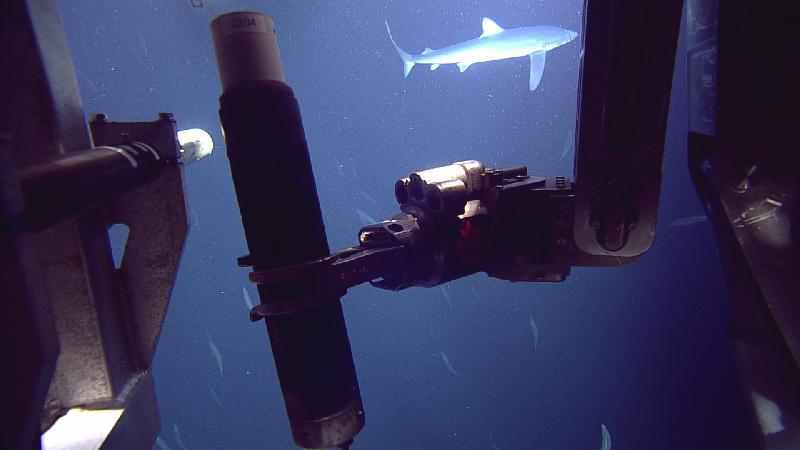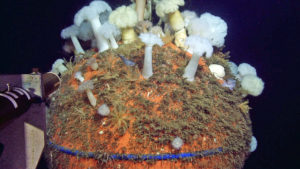

Happy Weekend to all the people on land out there! Here on the R/V Thompson, living and working at sea is a 24 hour/7 day operation, and we have already seen and done a lot of very cool things in just these last couple of days!
We are currently on day 3 of Leg 3 of the Regional Cabled Array VISIONS’22 expedition. We departed Newport last Thursday at 12:45 pm with sunny skies, a strong sea breeze, and plenty of excitement with 11 new University of Washington students onboard.
A 4-hour transit brought us to our first site-Oregon Offshore. After dinner, ROPOS did a maintenance dive of the Deep Profiler mooring (PD01B) where we saw a peaceful cluster of sea anemones living on the spherical orange float at the top of the mooring. We also saw some "not so peaceful sharks" on camera acting a bit territorial. In fact, one may have nudged a light loose on ROPOS as it was getting ready to clean the wire that attaches the mooring to the seafloor and which hosts the instrumented Deep Profiler vehicle! After some repair, cleaning of the wire commenced without further incident (the wire stretches from the mooring at 94 meters depth down to the seafloor at 600m), and the deep profiler vehicle was successfully turned.

Right after the dive, Leg 3 students did their first CTD cast. Students took turns communicating with the winch operator via walkie talkie regarding which depths we wanted to stop the CTD rosette at and collect ocean water samples by shutting the open Niskin bottles on the rosette. The students then collected samples from the niskin bottles for follow-on oxygen, DIC, nutrients, and chlorophyll analyses. In the next few days, they will be shown how to analyze the oxygen samples onboard – a process that involves a sharp eye!

Another 2-hour transit brought us to our next site- Slope Base. ROPOS did another dive to clean and turn the Deep Profiler vehicle (DP01A), and another CTD cast was taken afterwards. The seafloor is considerably deeper here at 2900 m, therefore, both the ROPOS dive and CTD cast took longer. ROPOS descends at ~ 25 m/minute so it takes nearly two hours to reach the seafloor at Slope Base.
We are now in the middle of our 18-hour transit to Axial Base at the foot of Axial Seamount (2600 m) where we are expected to arrive between 2200-2300 tonight. There are more dives to be done, more CTDs to be cast, and a myriad of instruments to recover and deploy. Right now, the ship is cruising, and the sun is shining. It’s a great day to write some blogs, work on some projects, and catch some z’s so we can all be ready to conduct more science!
